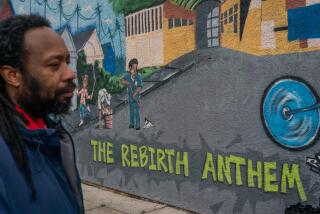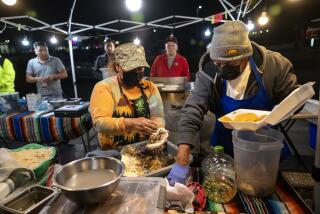Pulling the peddlers off the street
The hustle begins each day at sundown: “Computadoras!” “Bicicletas!” “Carne asada!”
For eight straight blocks along 6th Street in the Westlake neighborhood near downtown, sidewalks are so crowded with vendors and their wares that shoppers barely fit. Cumbia music booms and everything is sold “cheap, cheap, cheap.”
It is a peddler’s paradise — one that the city plans to begin replacing with its own licensed marketplace.
The ArtGricultural Market, a cross between a swap meet and farmer’s market, will open Saturday morning just a few blocks south of 6th Street, hoping to persuade merchants to legalize their hawking. Already, more than 80 have signed up.
But in an area where life seems to revolve around illegal street vending, organizers know change will not come easily.
Authorities have spent the last three months promoting the effort. Vendors, mostly illegal immigrants, were suspicious. They had to apply for a series of permits. To sell used goods (about 90% do) they had to be fingerprinted, enroll in a class taught by police and pay about $500 in fees.
“It’s crazy,” said Carlos Aguilar, who signed up a few weeks ago. “We just want to sell. We don’t have money for permits and rules and fees. We barely make enough to get by.”
But the 300 or so merchants crowding the corridor can’t be ignored, Councilman Ed Reyes said. “We’re giving people an opportunity to move on,” he said. “We don’t want to arrest them, we don’t want to take their goods, but we need them to live under the rules.”
For more than two decades, the vendors’ activities have presented a challenge to city officials.
Immigrants from Central America and Mexico streamed into the area in the 1980s, bringing with them vending customs common in their mercados and zocalos.
For many, selling tamales, jeans, pillows and flowers is a way of survival. And each day they play a game of cat-and-mouse with police — hiding along alleys, in apartment buildings and behind shops. Officers, far outnumbered, often focus on repeat offenders, vendors hawking pirated CDs and DVDs and those selling food.
The city tried to rein in the merchants during the late 1990s, offering those willing to follow its rules colorful wooden carts, business training and a kitchen space to cook according to county health standards.
But competition proved too much as scofflaw vendors began to steal customers. Those using the carts had to stay in designated spots at MacArthur Park. After three years, the program shut down.
Along 6th Street, vendors used to sell only on Fridays and weekends. Police regularly warned, cited and arrested them.
Then in 2010, things took a drastic turn.
A 37-year-old Guatemalan day laborer wielding a knife was killed by police on 6th Street near Union Avenue. People took to the streets in protest. To ease tensions, Police Chief Charlie Beck ordered officers to stop going after area vendors.
Meanwhile, Reyes’ office began to plan for the alternative street market, a $85,000 project paid for with federal dollars. It will be located on Little Street and operate Saturdays and Sundays from 10 a.m. to 6 p.m., with space for 120 vendors.
But when word spread that police had backed off, the number of merchants along 6th Street mushroomed. People poured in to set up shop, some from as far as Downey and El Monte. Fights broke out over spots, store keepers complained and the sale of pirated items, including pornography, shot up.
On a recent Saturday, the makeshift swap meet was in full swing, but many of the vendors knew their selling days might be numbered.
The city recently installed signs warning that street vendors faced arrest, fines of up to $1,000 and six months in jail.
LAPD Capt. Gina Sanders, who oversees the Westlake area, said police will begin by educating and warning vendors in coming weeks.
“We’re going to try to get people to not set up or to move to the new market,” she said. “For those who don’t follow, we’ll have to begin enforcement.”
Blanca De Garcia, 61, sat behind stacks of woven gloves and hats, unsure of her next step. She’s sold on 6th Street for more than 20 years. Some days she makes $2, others $30.
“I’m going to wait and see how things go for others at the new place,” she said. “Then I’ll decide if it’s worth it.”
A 37-year-old man named Juan, who declined to give his last name, was more willing to try his luck.
He figures it’ll be easier to set up his video games, cell phone chargers and other electronics at the new market.
“This place,” he said looking up and down 6th Street, “has gotten to be too much for me to handle.”
esmeralda.bermudez@latimes.com
More to Read
Start your day right
Sign up for Essential California for news, features and recommendations from the L.A. Times and beyond in your inbox six days a week.
You may occasionally receive promotional content from the Los Angeles Times.







